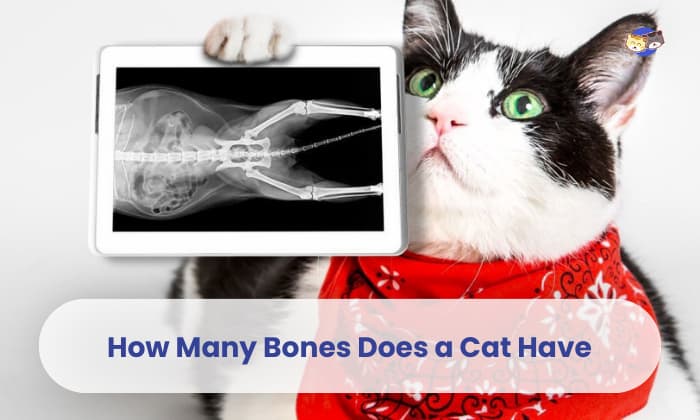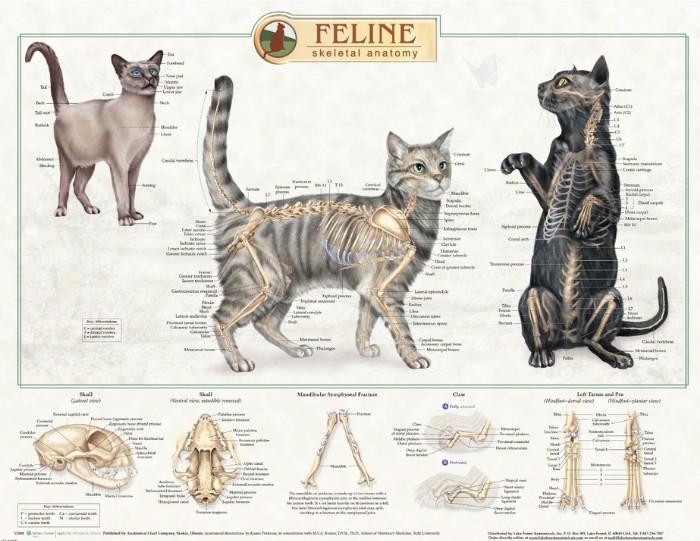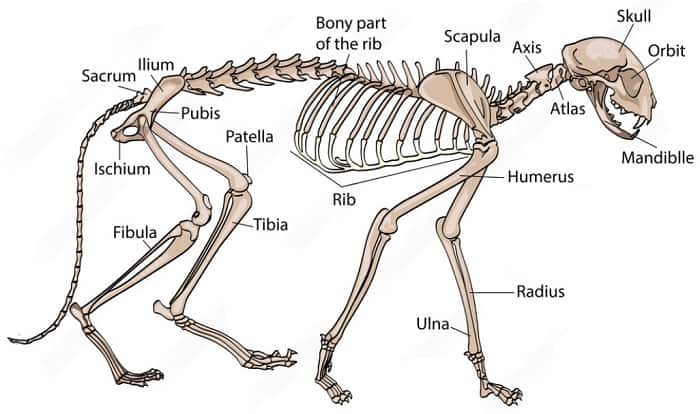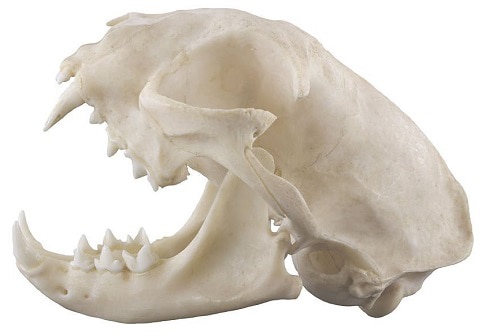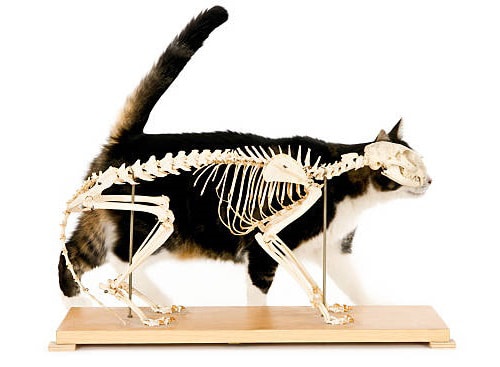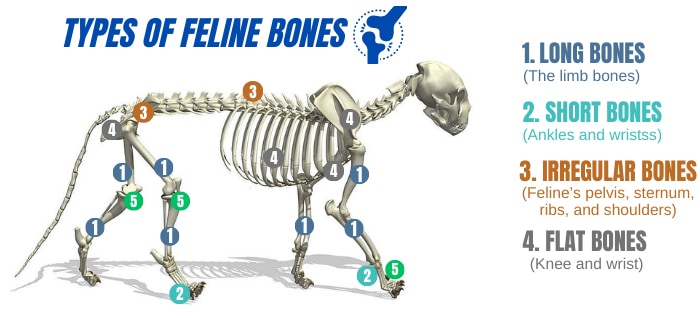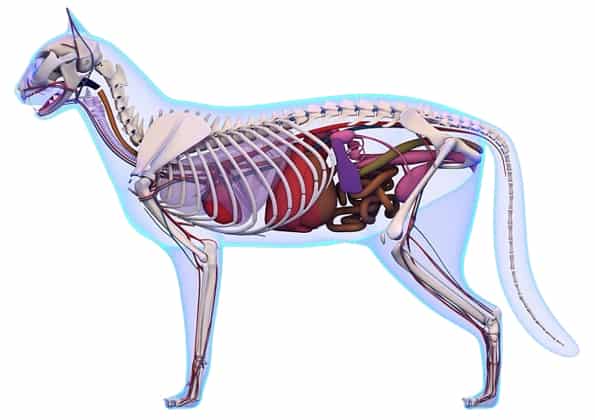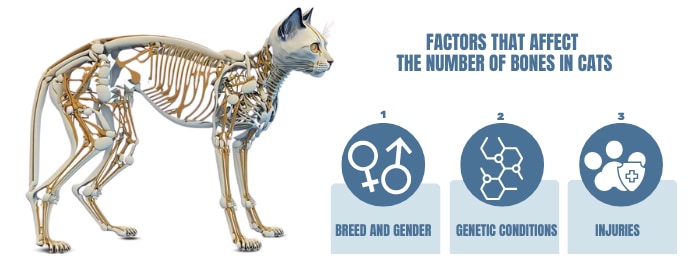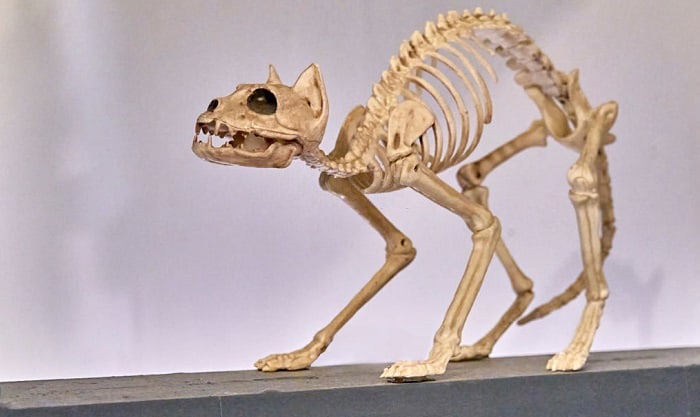A cat’s anatomy isn’t something people often talk about. So, when you ask a feline owner how many bones a cat has, chances are they don’t know the answer.
Feline bones are a mystery to those who don’t have a slight idea about them. Such is especially true considering how agile and flexible these animals are.
If you’ve ever wondered, “How many bones does a cat have,” the answer is 230 to 245. These bones help them with their flexible movements.
Table of Contents
How Many Bones Are in a Cat’s Body?
A cat’s skeletal system usually consists of 230 to 245 bones. The reason why the bone count is not a single exact number is that there are factors that can affect a cat’s bone development.
These factors include genetics, gender, breed, and certain developmental conditions like polydactyly – a condition where cats grow extra toes.
| Bone Type | Bone Name (To understand where these bones are located, refer to the anatomy diagram above.) | Number of Bones |
| Head |
|
29 |
| Cervical
The bones in a cat’s neck area |
|
7 |
| Inner Ears |
|
3 each in its ear |
| Throat | Hyoid | 1 |
| Thoracic
The chest bones |
T1 to T13 | 13 |
| Lumbar
Bones on the lower back of a cat |
L1 to L7 | 7 |
| Sacral
Located between the hip bones of a feline |
Sacrum | 3 |
| Caudal
The tail bones |
C1 to C23 | 20 to 23 |
| Ribs | 13 for each side of the body | |
| Shoulders | Scapula | 1 each shoulder |
| Sternum
The cat’s breastbones |
|
3 |
| Clavicle
Also known as the collarbone |
1 | |
| Pelvis |
|
3 each side |
| Forelimbs |
|
3 each side |
| Hindlimbs |
|
3 each side |
| Kneecaps | Patella | 1 for every hind leg |
| Carpal
Located at the wrists or above the paws of a cat |
|
14 |
| Tarsal
Heel and ankle bones |
|
16 |
| Feet |
|
18 |
| Phalanges
The toe bones |
Each feline toe consists of 3 bones – Distal, middle, and proximal bones. |
|
| Penis | Baculum | 1 |
Function of Cat Bones
The head, back, legs, and tail are the main cat body parts that help their movements. And while felines are quite flexible, they have strong bones that keep these body parts strong.
1. Skull
As listed above, there are 29 small bones fused together to form a cat’s skull. These bones provide the cat’s head with strength, rigidity, and protection.
The bones in a cat’s skull protect several vital organs, including the brain and eyes. The bone that encases its brain is particularly thick to protect the brain from any external impact.
Another strong bone located at the cat’s head is its jawbones. Since felines are predatory animals, their jawbones are extra strong, allowing them to tear down the flesh of their prey.
Some other bones in a cat skull are facial bones, namely the eye orbit, nasal bones, and cheekbones.
2. Neck, Spine, And Tail
The spine of a cat runs down from its neck down to its tail. Not only do these bones support a feline’s muscle but they also support the entire skeletal system.
Vertebrates make up the neck, spine, and tail of felines. Ligaments connect these vertebrates.
But unlike the human spine, the ligament connection is not very tight, allowing these furry animals to flex their backs.
Apart from flexibility, the bones in a cat’s tail allow them to balance their movements. This way, they can stay upright when they jump from high spaces or run fast.
3. Torso And Limbs
Cats owe their agility to their leg bones – a skeletal feature that makes their anatomy and physiology interesting.
Felines have collarbones. But unlike the human clavicle, these collarbones are not attached to their shoulders.
Since these collarbones are not connected to any joint, cats can get into tight spaces with so much ease.
Moreover, the frontal limbs of felines are the closest bones to their collarbones. Inside the limbs are the metatarsus, which is made up of foot bones, toes, and ankles.
Humans have metatarsus that starts from their toes to their ankles, thus making up the footpad. While felines have a similar bone structure, their metatarsus extends upwards rather than flat.
Meaning, the toes of felines serve as the footpad that they use for walking. This feature allows them to jump and absorb impact when they land.
Types of Feline Bones
- Long Bones. These are the limb bones. Their main function is to allow felines to move speedily while supporting their weight.
- Short Bones. The short bones of a cat are located in their ankles and wrists. Cats use these bones to perform fine yet stable movements.
- Irregular Bones. As the name suggests, irregular bones are bones that are neither long nor flat. Irregular bones include vertebrates and hip bones.
- Flat Bones. The main function of cat bones is to provide attachment for the long bones and muscles. You can find the flat bones in a feline’s pelvis, sternum, ribs, and shoulders.
- Sesamoid Bones. These bones are located near free-moving joints, including the knee and wrist.
Importance of the Cat Skeletal Structure
There are several reasons why feline bones are extremely important:
- Support And Structure. The bones of cats give them shape and form, supporting their bodies and posture as they walk, run, climb, and jump.
- Feline bones are connected by muscles, ligaments, and tendons. These connections allow flexible movements.
- Bones encapsulate the organs of cats, forming a protective barrier against potential damage. Some bones even provide attachment sites for vital organs.
- Blood Production. Inside certain bones is bone marrow, which aids in the production of red and white blood cells. These red blood cells are responsible for delivering oxygen throughout the body, while the white cells aid in immune system defense.
- Calcium Storage And Mineral Homeostasis. The bones act as a reservoir for minerals, particularly calcium and phosphorus. These minerals play vital roles in various physiological processes, including muscle contraction, nerve function, blood clotting, and maintaining the acid-base balance in the body.
Factors That Affect the Number of Bones in Cats
There are a few factors that affect kitten anatomy and the number of bones they have:
1. Breed And Gender
Felines have varying skeletal structures depending on their breed. While the overall numbers are not much different, this variation can be affected by selective breeding.
In terms of gender, a male cat has a baculum or penis bone, while a female cat obviously doesn’t.
2. Genetic Conditions
Genetic mutations can affect feline bone development. As a result, their bones change in structure.
For instance, some cats have a genetic condition called polydactylism. This condition causes them to have extra toes, thus resulting in more bones than normal.
Similarly, some felines do not have tails, so they have fewer bones than normal cats. Still, it is worth noting that such conditions are relatively rare.
3. Injuries
Severe injuries, such as when a bone is fractured or broken, can change the number of bones a feline has. Such conditions may either be temporary or permanent, depending on how severe the injury is.
Disorders of the Bones in Cats
- Hip Dysplasia. This bone disorder is a hereditary condition characterized by abnormal hip joint development. Some of its symptoms include lameness, inflammation, and difficulty in walking.
- Elbow Dysplasia. A feline genetic condition that primarily affects elbow joints. This condition results in lameness and may cause arthritis.
- A degenerative illness that affects felines’ joints and usually happens in older cats. Osteoarthritis happens when a feline’s joint cartilage wears down, resulting in pain and inflammation.
- A bone cancer that is common in older felines.
- Happens when a cat experiences severe injuries or accidents. Fractures can either be tiny cracks or complete breakage of bones.
The Discovery of the First Domestic Feline Skeleton
One of the most interesting cat skeleton facts is the discovery of the first domestic feline skeleton. According to archeologists, the bones of this cat are found in Dzhankent, Kazakhstan.
These bones were analyzed by a team led by Nottingham Trent University scientist Dr. Axel Barlow. The team found out that despite being well-preserved, the skeleton dates back to 775-940 cal CE.
Dr. Barlow and his team analyzed the DNA of this skeleton and confirmed that it was one of the earliest domestic cats.
Conclusion
You now have the answer to, how many bones does a cat have, as compared to humans, they indeed have more. While we have around 206 – 213 bones, a cat has at least 230 bones in their body.

I am Amy Sawy, a Doctor of Veterinary Medicine (DVM) graduate from the University of Kansas. y husband, Dr. Plummer, and I own a veterinary clinic in Phillipsburg, Kansas. In addition to my professional background, I am a devoted pet owner myself, with a household that includes dogs, rodents, and most notably, cats – a total of five felines in my home.
In 2020, I joined an organization as a professional writer, leveraging my experience and collaborating with my team to deliver the most valuable information for your cat’s care.


